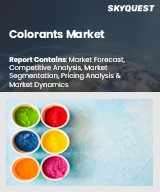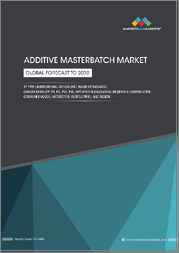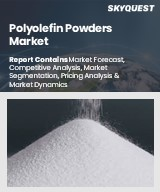
|
시장보고서
상품코드
1750242
세계의 마스터배치 시장 : 유형별, 폴리머별, 최종사용자 산업별, 지역별 - 기회 및 예측(2018-2032년)Global Masterbatch Market Assessment, By Type, By Polymer, By End-user Industry, By Region, Opportunities and Forecast, 2018-2032F |
||||||
세계 마스터배치 시장은 2025-2032년의 예측 기간 동안 5.12%의 연평균 복합 성장률(CAGR)을 나타내고, 2024년 120억 6,000만 달러에서 2032년 179억 8,000만 달러에 달할 것으로 예측됩니다. 이 시장은 여러 가지 이유로 인해 큰 활기를 띠고 있습니다. 마스터배치는 첨가제와 안료의 농축된 혼합물을 캐리어 폴리머에 담아 플라스틱 제조 특성을 더 나은 단계로 끌어올릴 수 있습니다. 포장, 자동차, 건설 관련 최종 용도에 의한 경량 재료 제품의 높은 사용률은 시장 성장을 증가시킬 것입니다. 또한 지속가능성에 대한 관심이 높아지면서 생분해성 및 환경 친화적 인 마스터 배치 제형에 대한 기술 혁신이 촉진되고 있습니다. 산업계가 환경 발자국 감소에 중점을 두면서 재활용 재료를 포함한 마스터 배치 솔루션의 채택도 증가하고 있습니다. 또한, 신흥 시장의 도시화와 경제 성장은 플라스틱 제품 소비를 촉진하고 마스터배치 수요를 촉진하고 있습니다.
예를 들어, 2024년 6월, Tosaf Compounds Ltd는 폴리프탈라미드(PPA)를 기반으로 높은 가공 온도를 가능하게 하는 안료를 사용한 새로운 컬러 마스터배치 캐리어 시스템을 개발했다고 발표했습니다. 새로 개발된 마스터배치는 재료의 특수한 특성에 영향을 주지 않고 다양한 밝은 색상의 제품을 만들 수 있다고 합니다.
목차
제1장 프로젝트의 범위와 정의
제2장 조사 방법
제3장 미국 관세의 영향
제4장 주요 요약
제5장 고객의 소리
- 구입 결정시에 고려되는 요소
- 품질과 퍼포먼스
- 커스터마이즈 옵션
- 비용 경쟁력
- 규제 컴플라이언스
- 애프터 지원
제6장 세계의 마스터배치 시장 전망, 2018년-2032년
- 시장 규모 분석과 예측
- 금액별
- 수량별
- 시장 점유율 분석과 예측
- 유형별
- 블랙 마스터배치
- 화이트 마스터배치
- 컬러 마스터배치
- 기타
- 폴리머별
- 폴리프로필렌
- 폴리에틸렌
- 고충격성 폴리스티렌
- 폴리염화비닐
- 폴리에틸렌 테레프탈레이트
- 기타
- 최종사용자 산업별
- 자동차 및 운송
- 포장
- 건축 및 건설
- 전기 및 전자
- 농업
- 기타
- 지역별
- 북미
- 유럽
- 아시아태평양
- 남미
- 중동 및 아프리카
- 기업별 시장 점유율 분석(주요 5개사 & 기타 - 금액별, 2024년)
- 유형별
- 2024년 시장 맵 분석
- 유형별
- 폴리머별
- 최종사용자 산업별
- 지역별
제7장 북미의 마스터배치 시장 전망, 2018년-2032년
- 시장 규모 분석과 예측
- 금액별
- 수량별
- 시장 점유율 분석과 예측
- 유형별
- 블랙 마스터배치
- 화이트 마스터배치
- 컬러 마스터배치
- 기타
- 폴리머별
- 폴리프로필렌
- 폴리에틸렌
- 고충격성 폴리스티렌
- 폴리염화비닐
- 폴리에틸렌 테레프탈레이트
- 기타
- 최종사용자 산업별
- 자동차 및 운송
- 포장
- 건축 및 건설
- 전기 및 전자
- 농업
- 기타
- 국가별 점유율
- 유형별
- 국가별 시장 평가
- 미국의 마스터배치 시장 전망, 2018년-2032년
- 시장 규모 분석과 예측
- 시장 점유율 분석과 예측
- 캐나다
- 멕시코
- 미국의 마스터배치 시장 전망, 2018년-2032년
제8장 유럽의 마스터배치 시장 전망, 2018년-2032년
- 독일
- 프랑스
- 이탈리아
- 영국
- 러시아
- 네덜란드
- 스페인
- 튀르키예
- 폴란드
제9장 아시아태평양의 마스터배치 시장 전망, 2018년-2032년
- 인도
- 중국
- 일본
- 호주
- 베트남
- 한국
- 인도네시아
- 필리핀
제10장 남미의 마스터배치 시장 전망, 2018년-2032년
- 브라질
- 아르헨티나
제11장 중동 및 아프리카의 마스터배치 시장 전망, 2018년-2032년
- 사우디아라비아
- 아랍에미리트(UAE)
- 남아프리카공화국
제12장 밸류체인 분석
제13장 Porter의 Five Forces 분석
제14장 PESTLE 분석
제15장 가격 분석
제16장 시장 역학
- 시장 성장 촉진요인
- 시장이 해결해야 할 과제
제17장 시장 동향과 발전
제18장 사례 연구
제19장 경쟁 구도
- 시장 리더 주요 5개사의 경쟁 매트릭스
- 주요 5개사의 SWOT 분석
- 주요 10개사 상황
- Ampacet Corporation
- Gabriel-Chemie GmbH
- Modern Dispersions, Inc
- Black Swan Graphene Inc.
- Cabot Corporation
- Tosaf Compounds Ltd
- LyondellBasell Industries Holdings BV
- Hubron International
- Plastika Kritis SA
- Avient Corporation
제20장 전략적 제안
제21장 회사 소개 및 면책조항
LSH 25.06.24Global masterbatch market is projected to witness a CAGR of 5.12% during the forecast period 2025-2032, growing from USD 12.06 billion in 2024 to USD 17.98 billion in 2032. The market has experienced great upsurges with multiple reasons. The masterbatch is a concentrated mixture of additives and pigments encapsulated inside a carrier polymer that enables the plastic production properties to come to better stages. High usage of the light material product by packaging, automotive, and construction-related end use increase the market growth. Additionally, the growing concern towards sustainability is also driving innovation in biodegradable and environment-friendly masterbatch formulations. With the focus of industries being on reducing their environmental footprint, the adoption of masterbatch solutions that include recycled materials is also increasing. Furthermore, urbanization and economic growth in emerging markets are driving the consumption of plastic products and fueling the demand for masterbatch.
For instance, in June 2024, Tosaf Compounds Ltd announced the development of a new color-masterbatch-carrier system based on polyphthalamide (PPA), with pigments that allow for high processing temperatures. This freshly developed masterbatch is said to make the products in many different bright colors without affecting the material's special properties.
Technological Innovation Driving the Global Masterbatch Market
Technology innovation is one of the key drivers of growth for the global masterbatch market since it greatly enhances product performance and expands application fields. Formulation technology advancement brought about the creation of masterbatches that are particularly beneficial for property enhancement such as UV stabilization, flame retardation, and antimicrobial properties. This has made it possible for producers to produce high-performing plastic products that shall fulfill enormously stringent industrial and consumer demands. Furthermore, the biodegradable and bio-based masterbatches has obtained the significance to fulfill the need for sustainable solutions because of the environmental consciousness. These masterbatches provide color and functional attributes along with higher levels of susceptibility to decomposition compared to conventional plastics and become sustainable in accordance with global initiatives.
Due to mounting pressure from industries to reduce plastic waste and carbon footprints, use of these masterbatch formulations will increase. In addition, innovation in production technologies, including better technology in extrusion and mixing that increases pigment and additive dispersion in the polymer matrix. This results in uniformity and stability in color quality as well as performance properties in produced batches and reduces waste and maximizes production. Smart manufacturing becomes more cost-saving and maximizes the output.
For instance, in March 2024, LyondellBasell Industries Holdings B.V. expanded its portfolio with the addition of the KARO 5.0 laboratory stretching machine. This new addition is expected to enhance the company's ability to test and develop masterbatch solutions intended for oriented film applications.
Rising Sustainability Concerns Driving the Demand for Black Masterbatch Solution
Growing environmental pressures are fueling demands for black masterbatch solutions in the automotive, packaging, agriculture, and construction sectors, among others. Producers are shifting towards black masterbatch solutions that embrace circular economic programs in a bid to decrease greenhouse gas emissions in an era where sustainability is the bottom line. With this move towards green materials, new forms of black masterbatch featuring recycled content and bio-based alternatives are being developed. These new products assist not only in addressing environmental issues but also in delivering improved performance properties in black masterbatches, such as UV stability and durability. Additionally, the greater emphasis on product design is propelling the black masterbatch demand as it gives a cool, sleek finish to different applications. Indeed, with industries shifting more towards sustainability and aesthetic trends, the black masterbatch market is projected to rise significantly, opening up opportunities for manufacturers to innovate and address the continuously evolving consumer choice in making the world a more sustainable place.
For instance, in November 2023, Cabot Corporation has introduced its REPLASBLAK family of circular black masterbatches with certified material. These products are the company's first-ever International Sustainability & Carbon Certification (ISCC PLUS) certified black masterbatch products powered by EVOLVE Sustainable Solutions. The REPLASBLAK round black masterbatches are manufactured to provide consistent performance, quality, and reliability in the plastics market, responding to the environmental concerns and greenhouse gas emissions savings across all industries including automotive, agriculture, packaging and construction.
Packaging End-User Industry Registering Rapid Growth in the Market
The end-user industry with the high growth rate for masterbatch is, the packaging industry led by rising e-commerce and consumer goods consumption demand for innovative packaging solutions and enhancing shelf-life product appeal. Moreover, the demand for sustainable packaging options is also driving this market, as companies seek to meet both regulatory requirements and consumer expectations for environmentally friendly products. The companies are making packaging solutions that have an ecological relevance by using masterbatches containing recycled content or biodegradable elements.
Furthermore, the packaging industry requires good-quality plastics that not only be beautiful but also will take in protection from UV rays and have good thermal stability. By using masterbatch, the manufacturer is able to make products that look beautiful while enhancing performance. Because of consumers' demand for packaged products, especially food and beverages, the demand for masterbatch solutions continuously increases. Innovation in the usage of masterbatch technology has emerged through packaged products along with the demand for increased shelf life. The need for more extended shelf life coupled with a growing interest in sustainable packaging solutions has motivated manufacturers to produce master batches not only effective but also friendly to the environment.
For instance, in July 2024, Black Swan Graphene Inc. launched graphene enhanced masterbatch (GEM) S27M which can be used for sustainable packaging. This 10% graphene nanoplatelet masterbatch is incorporated into high-density polyethylene (HDPE), offering transformative benefits. This is suitable for packaging applications like plastic bottles and waste bags. The integration of graphene and HDPE provides enhanced mechanical properties, such as superior strength and durability, making it suitable for various packaging applications.
North America Registering Growth in the Global Masterbatch Market
North America masterbatch market witnessing growth led by increasing interest in sustainable and green practices. In the countries the United Staes and Canada, commitment to reduction of plastic waste and increasing recyclability has led to increased demand for innovative masterbatch solutions in compliance with environmental regulations. The packaging sector is significant contributor as manufacturers also look for ways to present their products with attractive colors and designs that masterbatches deliver. In addition, the automotive and construction industries are increasingly adopting masterbatches to improve material performance and thus enhance the aesthetics of products further fueling expansion in the market.
Furthermore, the Governments initiatives, like the Action Plan for a Circular Economy, and stringent regulations on plastic use are forcing companies to think more sustainably. New regulations are spurring investment in advanced materials and technologies in Europe, which, in turn, makes the region an absolute giant in the masterbatch sector. Given these trends continue, the region will continue on that fast growth trajectory and one that is representative of a wider industry-wide commitment to sustainable development.
For instance, in February 2024, Modern Dispersions, Inc is in full operation with its first phase of a manufacturing expansion at its new 168-acre site in Fitzgerald, Georgia. The expansion aims to increase its masterbatch capacity by 100 million pounds per year, catering to the North American market. The expansion is in response to strong growth in injection molding and extrusion applications in automotive, electronics packaging, and construction. Key end-use applications include pipe, wire, and cable.
Future Market Scenario (2025 - 2032F)
The increasing trend towards customization in masterbatch solutions will provide opportunities for manufacturers to cater specifically to diverse industry needs while enhancing product performance.
Ongoing urbanization and economic development in emerging markets will further enhance consumption of plastic products, fueling demand for masterbatch solutions globally as industries seek efficient ways to meet consumer expectations while adhering to sustainability principles.
Innovations in biodegradable and eco-friendly masterbatch formulations will play a crucial role in meeting sustainability goals while addressing regulatory pressures surrounding plastic usage.
The increasing trend towards customization in masterbatch solutions will provide opportunities for manufacturers to cater specifically to diverse industry needs while enhancing product performance.
Key Players Landscape and Outlook
Global masterbatch market is competitive with the presence of several large players. Major manufacturers that enjoy reputations because of extensive variety products, innovation solutions, and all types of research and development processes in production. They look for upgradations in production lines, market outreach expansion through tie-ups and other collaborative work. In a highly competitive market of leading established players and new entrants that want to take up market space in the production of masterbatches for sustainable and high-performance applications, the investment is into research and development so that unique masterbatches can be formulated to answer different application demands such as packaging, automotive, and consumer goods.
In January 2024, Gabriel-Chemie GmbH announced its capacity expansion from its Hungarian production site, Nyiregyhaza, with an investment of about USD 6.34 million. Further, in June 2024, Ampacet Corporation expanded its ELTech portfolio to include high-performance color masterbatches based on polybutylene terephthalate (PBT) carrier resin, specifically designed for optical fiber cable PBT jacketing. PBT jacketing is used in building, construction, and data centers due to its mechanical properties, high strength, stiffness, and resistance to heat and chemicals.
Table of Contents
1. Project Scope and Definitions
2. Research Methodology
3. Impact of U.S. Tariffs
4. Executive Summary
5. Voice of Customers
- 5.1. Factors Considered in Purchase Decisions
- 5.1.1. Quality and Performance
- 5.1.2. Customization Options
- 5.1.3. Cost Competitiveness
- 5.1.4. Regulatory Compliance
- 5.1.5. After sale support
6. Global Masterbatch Market Outlook, 2018-2032F
- 6.1. Market Size Analysis & Forecast
- 6.1.1. By Value
- 6.1.2. By Volume
- 6.2. Market Share Analysis & Forecast
- 6.2.1. By Type
- 6.2.1.1. Black Masterbatch
- 6.2.1.2. White Masterbatch
- 6.2.1.3. Color Masterbatch
- 6.2.1.4. Others
- 6.2.2. By Polymer
- 6.2.2.1. Polypropylene
- 6.2.2.2. Polyethylene
- 6.2.2.3. High Impact Polystyrene
- 6.2.2.4. Polyvinyl Chloride
- 6.2.2.5. Polyethylene Terephthalate
- 6.2.2.6. Others
- 6.2.3. By End-user Industry
- 6.2.3.1. Automotive and Transportation
- 6.2.3.2. Packaging
- 6.2.3.3. Building and Construction
- 6.2.3.4. Electric and Electronics
- 6.2.3.5. Agriculture
- 6.2.3.6. Others
- 6.2.4. By Region
- 6.2.4.1. North America
- 6.2.4.2. Europe
- 6.2.4.3. Asia-Pacific
- 6.2.4.4. South America
- 6.2.4.5. Middle East and Africa
- 6.2.5. By Company Market Share Analysis (Top 5 Companies and Others - By Value, 2024)
- 6.2.1. By Type
- 6.3. Market Map Analysis, 2024
- 6.3.1. By Type
- 6.3.2. By Polymer
- 6.3.3. By End-user Industry
- 6.3.4. By Region
7. North America Masterbatch Market Outlook, 2018-2032F*
- 7.1. Market Size Analysis & Forecast
- 7.1.1. By Value
- 7.1.2. By Volume
- 7.2. Market Share Analysis & Forecast
- 7.2.1. By Type
- 7.2.1.1. Black Masterbatch
- 7.2.1.2. White Masterbatch
- 7.2.1.3. Color Masterbatch
- 7.2.1.4. Others
- 7.2.2. By Polymer
- 7.2.2.1. Polypropylene
- 7.2.2.2. Polyethylene
- 7.2.2.3. High Impact Polystyrene
- 7.2.2.4. Polyvinyl Chloride
- 7.2.2.5. Polyethylene Terephthalate
- 7.2.2.6. Others
- 7.2.3. By End-user Industry
- 7.2.3.1. Automotive and Transportation
- 7.2.3.2. Packaging
- 7.2.3.3. Building and Construction
- 7.2.3.4. Electric and Electronics
- 7.2.3.5. Agriculture
- 7.2.3.6. Others
- 7.2.4. By Country Share
- 7.2.4.1.1. United States
- 7.2.4.1.2. Canada
- 7.2.4.1.3. Mexico
- 7.2.1. By Type
- 7.3. Country Market Assessment
- 7.3.1. United States Masterbatch Market Outlook, 2018-2032F*
- 7.3.1.1. Market Size Analysis & Forecast
- 7.3.1.1.1. By Value
- 7.3.1.1.2. By Volume
- 7.3.1.2. Market Share Analysis & Forecast
- 7.3.1.2.1. By Type
- 7.3.1.2.1.1. Black Masterbatch
- 7.3.1.2.1.2. White Masterbatch
- 7.3.1.2.1.3. Color Masterbatch
- 7.3.1.2.1.4. Others
- 7.3.1.2.2. By Polymer
- 7.3.1.2.2.1. Polypropylene
- 7.3.1.2.2.2. Polyethylene
- 7.3.1.2.2.3. High Impact Polystyrene
- 7.3.1.2.2.4. Polyvinyl Chloride
- 7.3.1.2.2.5. Polyethylene Terephthalate
- 7.3.1.2.2.6. Others
- 7.3.1.2.3. By End-user Industry
- 7.3.1.2.3.1. Automotive and Transportation
- 7.3.1.2.3.2. Packaging
- 7.3.1.2.3.3. Building and Construction
- 7.3.1.2.3.4. Electric and Electronics
- 7.3.1.2.3.5. Agriculture
- 7.3.1.2.3.6. Others
- 7.3.1.2.1. By Type
- 7.3.1.1. Market Size Analysis & Forecast
- 7.3.2. Canada
- 7.3.3. Mexico
- 7.3.1. United States Masterbatch Market Outlook, 2018-2032F*
All segments will be provided for all regions and countries covered
8. Europe Masterbatch Market Outlook, 2018-2032F
- 8.1. Germany
- 8.2. France
- 8.3. Italy
- 8.4. United Kingdom
- 8.5. Russia
- 8.6. Netherlands
- 8.7. Spain
- 8.8. Turkey
- 8.9. Poland
9. Asia-Pacific Masterbatch Market Outlook, 2018-2032F
- 9.1. India
- 9.2. China
- 9.3. Japan
- 9.4. Australia
- 9.5. Vietnam
- 9.6. South Korea
- 9.7. Indonesia
- 9.8. Philippines
10. South America Masterbatch Market Outlook, 2018-2032F
- 10.1. Brazil
- 10.2. Argentina
11. Middle East and Africa Masterbatch Market Outlook, 2018-2032F
- 11.1. Saudi Arabia
- 11.2. UAE
- 11.3. South Africa
12. Value Chain Analysis
13. Porter's Five Forces Analysis
14. PESTLE Analysis
15. Pricing Analysis
16. Market Dynamics
- 16.1. Market Drivers
- 16.2. Market Challenges
17. Market Trends and Developments
18. Case Studies
19. Competitive Landscape
- 19.1. Competition Matrix of Top 5 Market Leaders
- 19.2. SWOT Analysis for Top 5 Players
- 19.3. Key Players Landscape for Top 10 Market Players
- 19.3.1. Ampacet Corporation
- 19.3.1.1. Company Details
- 19.3.1.2. Key Management Personnel
- 19.3.1.3. Products and Services
- 19.3.1.4. Financials (As Reported)
- 19.3.1.5. Key Market Focus and Geographical Presence
- 19.3.1.6. Recent Developments/Collaborations/Partnerships/Mergers and Acquisition
- 19.3.2. Gabriel-Chemie GmbH
- 19.3.3. Modern Dispersions, Inc
- 19.3.4. Black Swan Graphene Inc.
- 19.3.5. Cabot Corporation
- 19.3.6. Tosaf Compounds Ltd
- 19.3.7. LyondellBasell Industries Holdings B.V.
- 19.3.8. Hubron International
- 19.3.9. Plastika Kritis S.A
- 19.3.10. Avient Corporation
- 19.3.1. Ampacet Corporation
Companies mentioned above DO NOT hold any order as per market share and can be changed as per information available during research work.



















